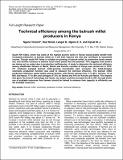| dc.contributor.author | Ngeno Vincent, Rop Wendi, B Langat, EK Ngeno, MJ Kipsat | |
| dc.date.accessioned | 2020-08-14T07:20:28Z | |
| dc.date.available | 2020-08-14T07:20:28Z | |
| dc.date.issued | 2011-08-18 | |
| dc.identifier.uri | https://repository.maseno.ac.ke/handle/123456789/2101 | |
| dc.description.abstract | South Rift Valley, which has some of the highest poverty levels in Kenya would greatly benefit from increased production of bulrush millet as it will both improve the diet and contribute to household income. Though south Rift Valley is suitable for growing of bulrush millet, its production levels remain low, and farmers continue to achieve much lower yields than the potential. This suggests that farmers are losing out on output due to production inefficiencies. A study to determine the technical efficiency among smallholder farmers in Narok, Bomet and Kericho counties of Kenya was carried out in 2010. 211 randomly sampled bulrush millet-growing households were surveyed. The Cobb-Douglas stochastic production function was used to measure the technical efficiency. The bulrush millet production efficiency varied widely among farmers, with Bomet varying from 11 to 83%, Kericho, 16 to 89% and Narok, 17 to 88% and averages of 72% for Bomet and 44% for Kericho and Narok. This implies that given the level of technology and inputs, the output could be increased by 28 to 56% through better use of available resources thus farmers should be trained to enhance their capacity to efficiently use the available resources. | en_US |
| dc.publisher | Academic Journals | en_US |
| dc.subject | Bulrush millet, stochastic production frontier, technical efficiency. | en_US |
| dc.title | Technical efficiency among the bulrush millet producers in Kenya | en_US |
| dc.type | Article | en_US |

